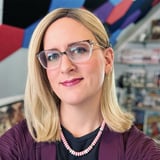Log in or create a free Rosenverse account to watch this video.
Log in Create free account100s of community videos are available to free members. Conference talks are generally available to Gold members.
Summary
There are two ways for organizations to grow: organically (i.e., through internal development) or inorganically (i.e., through mergers and acquisitions.) In this session, Jorge Arango discusses how designers can help their organizations grow inorganically. We cover design's role in creating a whole that's greater than the sum of its parts and learn three "plays" to help us chart a path towards more cohesive product experiences.
Key Insights
-
•
Inorganic growth via mergers often results in teams functioning side-by-side without true integration, causing fragmented user experiences.
-
•
Confusing product portfolios post-merger are common, with overlapping, complementary, or vaguely distinct offerings.
-
•
Misaligned terminology and multiple design systems contribute to incoherent experiences and redundant efforts.
-
•
Political and ego conflicts between acquired teams complicate integration beyond mere engineering challenges.
-
•
Design has strategic roles beyond production, including clarifying vision and facilitating organizational alignment.
-
•
Vision types are powerful artifacts akin to concept cars that help executives visualize long-term possibilities.
-
•
Design projects can serve as MacGuffins, catalysts that enable hard conversations and cultural integration.
-
•
Conceptual modeling helps teams agree on abstract system concepts before UI design, reducing ambiguity and conflict.
-
•
Successful mergers require a clear unified vision, aligned incentives, shared language, and executive support.
-
•
Balancing top-down vision with bottom-up user insights is crucial for meaningful product and cultural integration.
Notable Quotes
"Teams continue functioning kind of as they were for a while, running alongside each other like two rivers for miles without mixing."
"Confusing product portfolios often arise when two successful teams’ products overlap, complement, or have vague distinctions."
"Politics and ego conflicts are inevitable and separate challenges that seriously impact merger integration."
"Design is often seen as a production function but can and should be a strategic partner in organizational transformation."
"Steve Jobs’ product matrix simplified Apple’s sprawling portfolio and refocused their efforts, which arguably saved the company."
"A design project can become the catalyst for conversations where teams realize they have not talked to each other."
"Conceptual models are ideas about the world and how parts behave in relation to each other; they precede screen-level design."
"Culture eats strategy for breakfast—integrating cultures is the hardest and most critical part of mergers."
"Vision types help us envision ideal futures freed from near-term constraints but must avoid magical thinking."
"The whole should be greater than the sum of the parts, but achieving that requires intentional design and leadership."
Or choose a question:
















More Videos

"Slow and intentional communication allows you to be fully present rather than distracted by constant notifications."
Marc Fonteijn Ru ButlerIncrease your confidence, influence, and impact (through a Professional Community)
December 3, 2024

"Our apprentice program is free and intense, combining foundational training with real-world projects over six months."
Victor M. GonzalezPracticing Learners and Learning Practitioners
March 10, 2021

"You don’t need to be an expert in accessibility before doing user research with people with disabilities."
Elana Chapman Li Wen Huang Divyen Sanganee Annabel WeinerGetting started with accessibility research
February 20, 2025

"If your leadership isn’t aligned to your agenda, it’s vital to negotiate and influence to bring them on board."
Karen PascoeDeveloping Experience Teams and Talent in the Enterprise
June 8, 2016

"Users immediately assumed that a single identity meant our products would work together naturally, even before we proposed product connectivity."
Dawn ResselFull-Stack User Experiences: A Marriage of Design and Technology
June 9, 2016

"Designers can be really paranoid and very precious."
Gretchen AndersonScaling the Human Center
June 8, 2017

"Make sure children understand they can stop the session at any time, and confirm they really get that."
Mila Kuznetsova Lucy DentonHow Lessons Learned from Our Youngest Users Can Help Us Evolve our Practices
March 9, 2022

"Accessibility is a process, not a project."
Sam ProulxAccessibility: An Opportunity to Innovate
November 16, 2022

"Creating one adopted component can be harder than creating a hundred that never get used."
Nathan CurtisDesign Systems for Us: How Many One-Source(s)-of-Truth Are Enough?
January 17, 2019
















